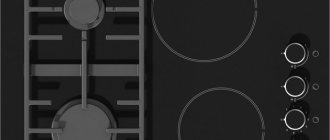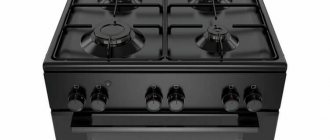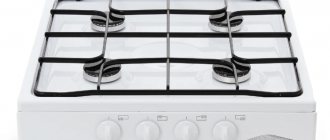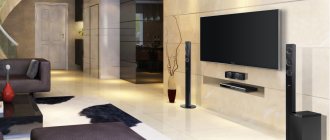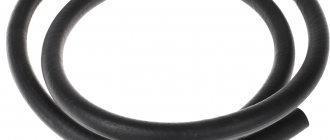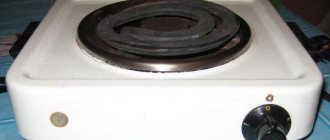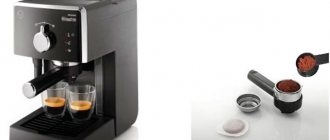Basic criteria for comparing cooking equipment
Before deciding what to choose: a hob or a stove for your kitchen, let’s outline the main criteria for the upcoming choice. Regardless of the design of the room and its size, the following factors become determining:
- design capabilities and appearance of each unit;
- dimensions and weight of the unit;
- price;
- installation conditions and technology;
- functionality and technical capabilities;
- power consumption.
Note! Only an integrated approach to purchasing kitchen appliances, taking into account all requirements and operating conditions, will allow you to make the right choice between the two types under consideration.
Criterias of choice
The hob can be portable and attached to the kitchen worktop using screws
If you are designing a new kitchen design or carrying out renovation work, then when choosing a device you should pay attention to several determining factors:
- Ease of use. Due to the convenience and ease of installation, many people choose a hob when choosing. It can be portable or built-in, which is attached to the kitchen countertop with screws.
- Practicality. Before making a choice between two devices, you should first make sure how practical the device will be in the kitchen, easy to use, effective in its operation, and also take into account the technical characteristics and other factors necessary to ensure the smooth operation of the device. The equipment must effectively cope with household tasks and meet your needs, without causing discomfort or other inconveniences when used in the kitchen.
- Advantages and disadvantages. Before purchasing, you should study the pros and cons of using an induction panel and a gas stove.
When comparing, you should pay attention to the following parameters:
- functionality;
- size;
- appearance and combination with the kitchen;
- weight of the device;
- installation technology;
- price;
- technical factors and energy consumption;
- personal preferences;
- terms of Use.
Dimensions and appearance
Gas stove
Gap between stove and cabinets
The main disadvantage of the stove is its volume, since it requires a lot of kitchen space, and the possibility of installation may be limited by the location of the gas pipeline.
Considering all these components, such a device is difficult to harmonize with the interior of the kitchen.
It is difficult to fit tightly between cabinets, resulting in gaps where dust, liquids and particulates can accumulate over time.
Induction device
The hob matches the design of the kitchen and is practical and easy to use
Compactness, light weight, attractive appearance and ease of installation are the main advantages of this equipment.
The hob will free up a lot of space in the kitchen and can be installed on almost any countertop.
It goes well with the kitchen design and is practical and easy to use. In the appropriate design, you will also need to choose an oven, which should harmoniously combine with the interior.
Easy to install and operate
Connecting a gas hose when connecting a gas stove
Connecting a gas stove is based on a complex connection of a gas hose and gas pipes. The connection must be made by gas service employees.
The greatest demand is for a gas stove combined with an electric oven, which provides greater functionality than justifies its high cost.
The hob is easy to install and operate. The built-in device simplifies cleaning the room, because, unlike a gas stove, it does not form gaps and does not accumulate debris.
The induction panel on the market is found with a glass surface, glass-ceramic or stainless steel. The glass plane is easier to maintain than stainless steel and other materials.
Functionality
Built-in induction hobs are a better alternative than conventional gas stoves for several reasons:
- Ease of use. They have a pulse ignition function, which is controlled by a control knob.
- Fast and convenient preparation. Some built-in cookers are equipped with a multi-flame function.
- Safety. Using an induction device is a safer option. Modern hobs are equipped with a function to shut off the gas supply if the flame on the equipment goes out. This innovative feature also helps you save gas.
- Additional functions. Modern appliances come with additional features such as alarm systems and timers that can be used to prevent overcooking and burning of food.
Economical
How the hob works
Some modern cooking appliances are more economical than gas burners due to their moderate consumption of electricity and other resources.
Heating elements help quickly heat up the dishes and achieve the required temperature.
Features of the appearance of a gas stove and hob
Every year manufacturers show more and more imagination. The color range of the equipment is amazing, and the specific shape satisfies the needs of any room shape. Considering individual models - hob and stove, we note the following points:
- Induction often looks organic and advantageous. One of the nuances is that you will have to buy an oven in the appropriate style. And this problem is not as easy to solve as it might seem at first glance. In any case, in terms of external indicators, the stove will fit perfectly into the interior and will look fresh and fashionable.
- An oven is originally a single piece of equipment that has many functions for preparing all types of food. In this case, it will be enough to simply decide on the desired variation, based on the overall stylistic decision of the kitchen.
Hob Features
If you don’t plan to use an oven, you can skip the space with an electric stove and choose a compact, stylish hob. It is mounted into the countertop, and there is plenty of space underneath for equipping kitchen drawers and installing a dishwasher. The one-piece design makes cleaning easy and fits seamlessly into any environment.
On sale today you can find older enameled models, as well as glass-ceramic options. Depending on the modification, you can choose an induction, gas or mixed system.
Advantages of an electric hob
The first plus is aesthetics. There are no rough switches or grates with burners - the heating zones are simply applied to the surface. You can place such a panel on almost any countertop, because it does not take up much space and is suitable even for a small kitchen.
Cleaning also does not take much time, because during installation all joints are carefully closed, and dirt does not accumulate there. Simply wipe the surface with a cloth to remove small stains.
Many people worry that at some point they will want to buy an oven, but will not be able to install it. But the oven can be purchased separately, and it is absolutely not necessary to place it above the hob - these two types of equipment can work independently of each other.
Another important plus is faster food preparation due to the fact that modern burners are more powerful.
Disadvantages of the hob
The first thing that stops many buyers is the price. You will have to pay a lot not only for high-quality equipment, but also for its installation. You can try to install the panel yourself, but you need to perfectly fit it to the size of the cut opening in the countertop, so that dirt does not get into the cracks later.
It is also important to properly organize the ventilation system so that during the cooking process, excess heat does not affect nearby furniture, which could catch fire.
Additional costs also await those who buy a separate gas-based panel and oven - each type of equipment will require a separate hose. Such changes will have to be coordinated with the gas service, a separate project must be drawn up and the services of a specialist must be used, since such work is prohibited from being carried out independently.
Despite the ease of care, the surface is very sensitive. Chips may appear on the enamel or glass even after one awkward movement, and grains of sugar accidentally left on the stove during heating are a direct path to cracks. Fixing any defect or problem will be expensive.
IMPORTANT! Most ceramic or glass hobs can withstand a weight of no more than 15–17 kg overall and up to 5–6 kg on each burner. So, it will be difficult to cook a lot of food for a large family at once.
Dimensions and weight of the food preparation unit
If we consider dimensions and weight as a criterion for choosing equipment, then in this case the question is “which is better?” solved much faster.
- An ordinary stove, even a new-fangled, improved model, is bulky and heavy, so you need to take care in advance about the future location of its installation and the configuration of kitchen furniture nearby. If you plan to cook often and a lot, especially when cooking for the winter, then you should remember that the stove will withstand any weight load without restrictions.
- The built-in cooking surface takes up little vertical space, is very compact, and allows for the most useful and efficient use of the space underneath. Of the minuses, we note that the maximum load on one burner is 5 kilograms, and in general for the entire area no more than 15 kilograms.
Important! Remember that if you are going to purchase an oven for built-in appliances, then compactness and space saving are not relevant in this case.
Installation conditions and technology
When choosing what is easier and faster to install: an electric oven, hob or gas stove, you should consider the following points:
- An electric oven can be easily installed in any corner of the apartment without restrictions. Electric operation requires only an outlet and no additional expenses for the services of professional installers.
- To install a gas model, a clear calculation of the dimensions of the unit and the installation location and dimensions of other furniture is required. Connection and commissioning are carried out exclusively by special service employees.
Important! Combined devices require installation by professionals, since gas is the priority hazard.
- The induction cooker must be installed by craftsmen with the appropriate qualifications and profile, since they are built into kitchen furniture. In addition, it is necessary to carefully prepare the furniture itself: mark and make precise cuts so that there are no large cracks or gaps left after installing the equipment.
Kitchen stove - a time-tested technique
Despite the fact that the household appliances market is constantly updated with new products, many people prefer to install conventional electric and gas stoves in their kitchens. But if the hob also runs on electricity and gas, the question arises, why is a stove preferable? How is it better?
- A stove is cheaper than a hob and oven.
- Free-standing equipment has an advantage during installation. There is no need to prepare a new place in the kitchen; just connect it to an existing gas pipe or electrical network.
- The stoves already have an oven built into the body with gas, electric or combined heating.
- Models of stoves with a work surface made of tempered glass, stainless steel and glass ceramics are not only convenient to use, but also decorate the kitchen.
Functionality and technical indicators
It is difficult to accurately answer the question of which stove is better, an electric one (not a hob) or a gas one. In this case, the comparison depends on each person's personal priorities.
- Ease of use and functionality are often determined by the type of energy consumption. Gas ones allow you to cook dishes as quickly and naturally as possible, and also have the ability to accurately set the flame in the burner. Electric models are somewhat inferior in terms of cooking speed and temperature accuracy, but they are many times safer.
- The speed of heating and cooling of the burners, and therefore the power of the built-in panel, depends on the principle of operation and the material of execution. A limited number of dishes in terms of weight, volume and type are often prepared on such a surface. Of all the options, built-in surfaces are called the safest, since in the absence of dishes the oven does not heat up. In addition, modern models have diverse functions - timers, auto shut-off, saving energy consumption.
To quickly decide, it is important to remember the following nuances:
- If you have a choice: a stove or a built-in panel, but you want to buy an electric oven without an oven, then in this case, take the hob type.
- If you are choosing between a gas or built-in surface, if you have a family and a love of cooking, then it is better to give the palm to the classics of the genre.
Comparative characteristics
Traditional summing up from our experts. Let's compare the products discussed above and see who is the best.
| Gas stove | Gas panel | |
| Appearance | Neat, classic design. Possibility of choosing a suitable model for a particular interior | Ergonomic, stylish design. Possibility of choosing an individual model (shape, size, color) to suit any interior |
| Dimensions | From 30 cm (standard – about 60 cm) | From 30 cm in width (they are compact in size and come in non-standard shapes) |
| Installation technology | Installed not far from the gas distribution system, self-installation is possible | Installation requires professional assistance |
| Functionality | Allows you to prepare any food in any volume | They depend mainly on the material used in the manufacture of the panel (the speed of heating and cooling of the burners limits the variety and complexity of the prepared dishes) |
| Price | Low to high | Low to high |
Generalized advantages and disadvantages of induction
Based on all of the above, let’s summarize.
Advantages of this type
- Heating occurs faster than with gas, for example, 5 liters of water boils on induction in 4 minutes, and on gas in 12;
- 4 times more economical than heating element;
- during cooking, you can lay a towel under the frying pan, or simmer dishes without a lid;
- dishes and furniture are not smoked;
- many programs and timers;
- temperature regulation without accidentally extinguishing the fire.
Disadvantages of the induction model
- relatively fragile surface;
- special utensils or adapters are required;
- Aluminum and copper utensils are not suitable;
- for certain models you will have to derive a separate phase.
Advantages and disadvantages of gas stoves
Let us summarize all the information collected about gas stoves:
Advantages of gas
- there are no problems with purchasing specialized utensils;
- no dependence on power outages;
- often the price of gas is lower than that of electricity;
- There are no problems with wiring.
Disadvantages of this type
- increased risk of explosion;
- the need to legitimize any movement of the unit;
- cleaning the gas model is more labor-intensive;
- Gas smokes when burned, so an exhaust hood is needed.
Which option to choose depends on personal preferences and the capabilities of your wallet. Weigh the pros and cons, and you will definitely make the right choice.
